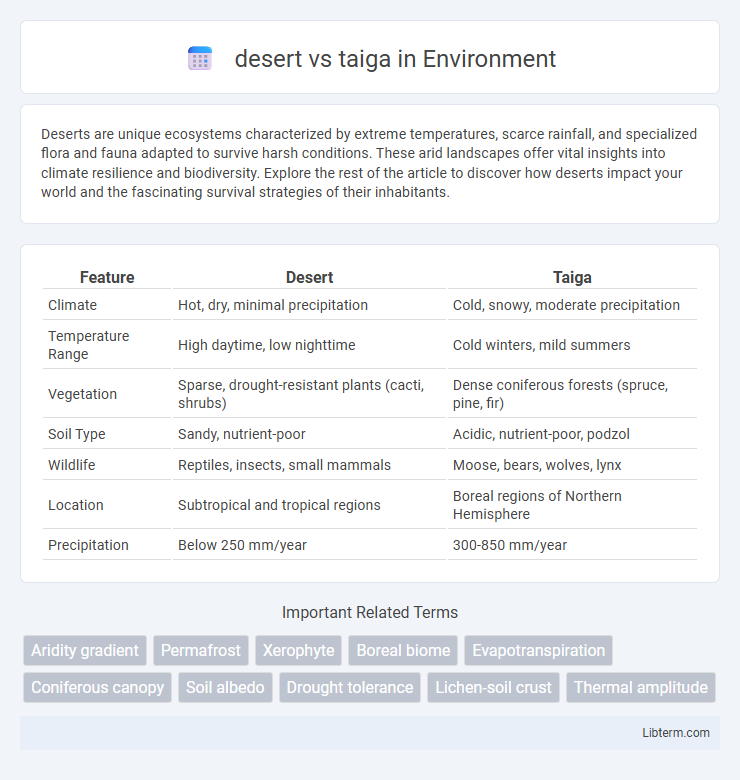Deserts are unique ecosystems characterized by extreme temperatures, scarce rainfall, and specialized flora and fauna adapted to survive harsh conditions. These arid landscapes offer vital insights into climate resilience and biodiversity. Explore the rest of the article to discover how deserts impact your world and the fascinating survival strategies of their inhabitants.
Table of Comparison
| Feature | Desert | Taiga |
|---|---|---|
| Climate | Hot, dry, minimal precipitation | Cold, snowy, moderate precipitation |
| Temperature Range | High daytime, low nighttime | Cold winters, mild summers |
| Vegetation | Sparse, drought-resistant plants (cacti, shrubs) | Dense coniferous forests (spruce, pine, fir) |
| Soil Type | Sandy, nutrient-poor | Acidic, nutrient-poor, podzol |
| Wildlife | Reptiles, insects, small mammals | Moose, bears, wolves, lynx |
| Location | Subtropical and tropical regions | Boreal regions of Northern Hemisphere |
| Precipitation | Below 250 mm/year | 300-850 mm/year |
Introduction to Desert and Taiga Biomes
Desert biomes are characterized by extremely low precipitation, often less than 250 mm annually, resulting in sparse vegetation and extreme temperature fluctuations. Taiga biomes, also known as boreal forests, cover vast regions of the Northern Hemisphere with dense coniferous forests adapted to cold, long winters and moderate precipitation between 300-850 mm per year. Both biomes support unique ecosystems shaped by their distinct climate conditions, soil types, and plant adaptations.
Defining Characteristics of Deserts
Deserts are defined by their extremely low precipitation, typically less than 250 millimeters annually, resulting in sparse vegetation and arid soil conditions. Temperature fluctuations in deserts can be extreme, with scorching daytime heat and significantly cooler nights, influencing unique adaptations in flora and fauna. Unlike the taiga, known for its dense coniferous forests and cold climate, deserts support specialized drought-resistant plants like cacti and animals adapted to conserve water.
Key Features of Taiga Ecosystems
Taiga ecosystems, also known as boreal forests, are characterized by dense coniferous trees such as spruce, fir, and pine, adapted to cold climates and long winters. These forests support diverse wildlife including moose, lynx, and migratory birds, with soil often acidic and nutrient-poor due to slow decomposition rates. Unlike deserts, taigas receive moderate precipitation, primarily as snow, which sustains their unique plant and animal life through harsh seasonal changes.
Climate Comparison: Arid vs. Cold
Deserts experience arid climates characterized by extremely low precipitation, often less than 250 mm annually, coupled with high daytime temperatures and significant diurnal temperature variation. Taigas, or boreal forests, have cold climates marked by long, harsh winters with temperatures frequently dropping below -20degC, and moderate to high precipitation primarily in the form of snow. These contrasting climate conditions define desert ecosystems with sparse vegetation adapted to drought, while taigas support dense coniferous forests adapted to cold and moisture.
Soil Composition and Fertility
Desert soils are typically sandy or rocky with low organic matter, poor nutrient content, and limited water retention, resulting in low fertility and sparse vegetation. Taiga soils, known as podzols, have acidic, nutrient-poor profiles but contain more organic material from decomposing conifer needles, supporting a denser forest ecosystem despite slower nutrient cycling. The contrast in soil composition directly influences the types of plants and animals adapted to each biome's harsh conditions.
Flora Adaptations in Deserts and Taigas
Flora adaptations in deserts include succulent leaves and deep root systems to conserve and access scarce water, while taiga vegetation features needle-like leaves with waxy coatings to reduce water loss and withstand freezing temperatures. Desert plants exhibit CAM photosynthesis to minimize daytime water loss, whereas taiga conifers have antifreeze proteins and flexible branches to survive heavy snow loads. Both ecosystems demonstrate specialized traits enabling plant survival under extreme environmental stressors.
Fauna Diversity and Survival Strategies
Desert fauna exhibits adaptations such as nocturnal behavior, water conservation through specialized kidneys, and burrowing to escape extreme heat, enabling survival in harsh, arid conditions. Taiga fauna displays thick fur, hibernation, and seasonal migration to endure cold temperatures and scarce food availability during long winters. Both biomes demonstrate unique evolutionary strategies to optimize energy use and maintain biodiversity despite environmental stressors.
Human Impact and Land Use
Human impact in deserts is often characterized by water extraction, mining, and off-road vehicle use, leading to soil degradation and habitat disruption. Taiga regions experience extensive logging, mining, and infrastructure development that contribute to deforestation and biodiversity loss. Both ecosystems face challenges from climate change and land conversion, but taiga's dense forests are particularly vulnerable to large-scale industrial exploitation.
Environmental Challenges and Conservation
Deserts face extreme water scarcity and temperature fluctuations, leading to fragile ecosystems prone to erosion and biodiversity loss, while taigas endure harsh cold, nutrient-poor soils, and increased vulnerability to wildfires and pest outbreaks. Conservation efforts in deserts emphasize sustainable water management and habitat protection, whereas taiga initiatives focus on fire control, reforestation, and mitigating climate change impacts. Both biomes require targeted strategies to preserve their unique species and maintain ecological balance amid growing environmental pressures.
Conclusion: Desert and Taiga — Contrasting Worlds
Deserts and taigas represent two drastically different ecosystems defined by unique climate conditions, biodiversity, and adaptations. Deserts are arid landscapes with extreme temperature fluctuations and sparse vegetation, while taigas are cold, boreal forests characterized by dense coniferous trees and moderate precipitation. Understanding these contrasting worlds highlights the diverse ways ecosystems evolve to survive in challenging environments.
desert Infographic

 libterm.com
libterm.com